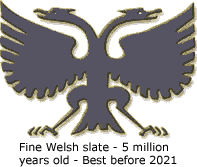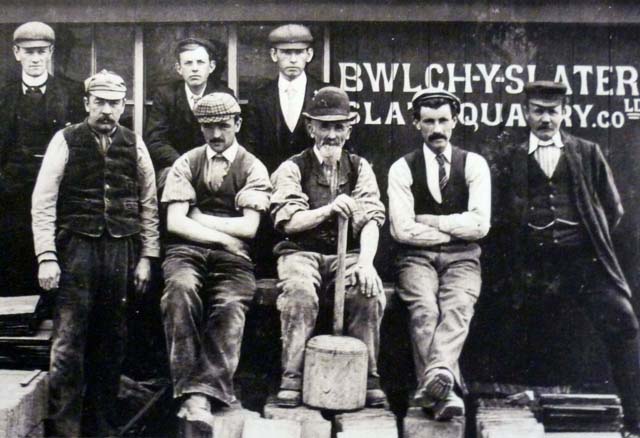Welsh quarrymen - Date? Photographer? Slate is a fine-grained metamorphic rock derived from an original shale-type sedimentary rock composed of clay or volcanic ash. It is mainly used for roofing, but is also produced as thicker slabs for a variety of uses. The slate industry grew slowly until the early 18th century, then expanded rapidly until the late 19th century, at which time the most important slate quarries were in northwest Wales, except for Blaenau Ffestiniog, where slate was mined rather than quarried. This map There were several different categories of worker in the quarries. The quarrymen proper, who made up just over 50 percent of the workforce, worked the slate in partnerships of three, four, six, or eight men known as "bargain gangs". A gang of four typically consisted of two rockmen Soap was a heavily taxed luxury item that only the rich could afford in Britain until Gladstone's budget of 1853 removed the soap tax. But tradition determined that if it was used, it was used sparingly, or replaced with lye. A quarryman's wife must have lived with an awful smell, washing her husband's shirt only once a month, or every two weeks if she was fussy. He went to bed in his shirt, vest, and flannel drawers which he'd worn all day sweating in the quarry. Quarrymen were afraid air or water might contact their skin, aside from their hands and face, of course. Laundering was labour intensive being accomplished with lye made from a mixture of wood ash, taken from grates or ovens, water, and perhaps urine. Sometimes domestic fowl droppings were added. Clothes were agitated in a barrel using a three-legged dolly peg. Should anyone be prosperous enough to own silk the item would be cleaned in liquid made from boiling grated potatoes in water. Underground quarrymen worked in a dense, foggy, and frequently un-wholesome atmosphere. The quarry and slate sheds, being dusty, caused thirst which was eliminated by drinking tea. In the morning they drank one or two cups then took tea with them in cans to drink during meal break. When returning home in the evening they often had nothing but tea once again. The common diseases of the Blaenau Ffestiniog quarryman were diseases of the respiratory organs, rheumatism, and alimentary diseases such as indigestion. It was believed indigestion was due to the way they prepared their tea. It was their habit to send a boy, about a half hour before mealtime, to the caban In 1893 the average age at death of those working in Blaenau Ffestiniog quarries and mines was 54 excluding accidents, only 52.6 if you include accidents. During 1883-1892 there were 473 deaths in the slate industry. 73 were recorded as having died of Phthisis (also know as Consumption but properly known as Tuberculosis) and named in Welsh, Peswch y Llifiant (rasping cough). 43 of these were slate splitters and dressers, 19 rockmen and miners, 10 labourers Men working the mills were coated with white dust. The slate dust particles are angular and give rise to irritation and coughing when inhaled. The term "silicosis" was first heard in Britain in 1870 but never known at Blaenau Ffestiniog even twenty years later.  Slate quarries at Blaenau Ffestiniog were actually enormous underground chambers. At Llechwedd there are sixteen levels of them, one above the other. Llechwedd Slate Mines was founded in 1846 by John Whitehead Greaves. Over time, 25 miles of underground railway serviced Llechwedd. Huge chambers up to 50 or 85 feet in height were created. Quarrying was carried out entirely by candlelight. It could take two men up to twenty years to excavate just one chamber. All useable slate blocks plus the rubble had to be winched to the surface for splitting into roof slates or disposal on a tip. It was dangerous work down there in the dark. J.W. Greaves was a pioneer in the development of the slate sawing table |





